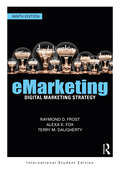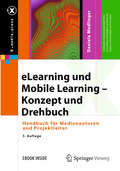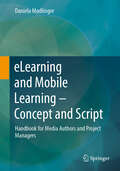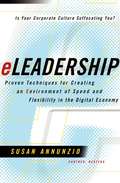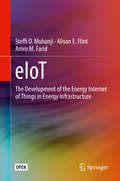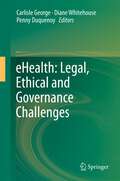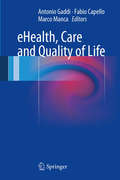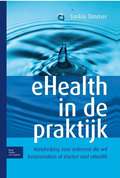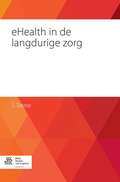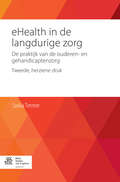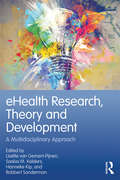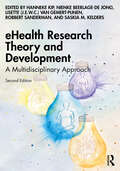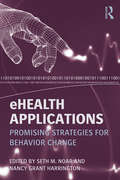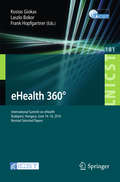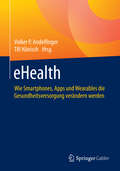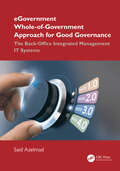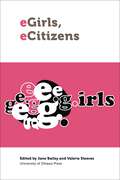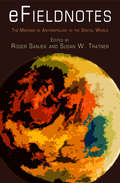- Table View
- List View
eMarketing: Digital Marketing Strategy
by Raymond Frost Alexa K. Fox Terry DaughertyeMarketing, 9th edition, equips students with the solid foundation in digital marketing required to excel in practice and "think like a marketer". The book connects digital marketing topics with the traditional marketing framework, making it easier for students to grasp the concepts and strategies involved in developing a digital marketing plan. With a strategic approach that focuses on performance metrics and monitoring, it is a highly practical book. The 9th edition has been fully updated to include the most cutting-edge trends and topics, including SEO, customer experience, digital media consumption, analytics, big data and AI, and diversity and ethics. Case studies and examples have been updated across the book to demonstrate marketing practice in real organizations globally. Pedagogical features support the theoretical foundation throughout, incorporating "success stories" and "let’s get technical" boxes, as well as activities at the end of each chapter, to aid students in their understanding of, and ability to execute, successful digital marketing strategies. Highly regarded and comprehensive, this textbook is core reading for undergraduate students studying digital marketing and digital business. Online resources include PowerPoint slides and a test bank.
eLearning und Mobile Learning – Konzept und Drehbuch: Handbuch für Medienautoren und Projektleiter (X.media.press)
by Daniela ModlingerIn dem Praxishandbuch beschreibt die Autorin, wie ein Drehbuch nach lernpsychologischen und didaktischen Kriterien erstellt werden kann. Sie stellt Werkzeuge für das Konzipieren und Schreiben vor und evaluiert sie. Das Buch und die begleitende Website bieten zahlreiche Hilfsmittel: u. a. eine Checkliste zur Prüfung des fertigen Drehbuchs und eine Qualitätssicherungsmaßnahme, die Zeit und Kosten spart. Die Neuauflage wurde durchgehend aktualisiert. Für Projektleiter in Multimediaagenturen, Fachleute in Unternehmen sowie (zukünftige) Drehbuchautoren.
eLearning for Quality Teaching in Higher Education: Teachers’ Perception, Practice, and Interventions
by Nan YangThis book explores the impact of eLearning on the quality of teaching in higher education, focusing on three main issues: university teachers’ perception of quality teaching, their strategies for achieving quality teaching in practice, and interventions that design and implement online collaborative activities in a large class. The book argues that if eLearning targets the real problems in practice and is appropriately designed and implemented, it can improve the teaching quality at universities. It also demonstrates the complexity of teachers’ perception of quality teaching and contextual factors that affect teaching practice and quality. Further, it explores university teachers’ perception of quality teaching in Italy, the UK and China – an aspect that is rarely addressed in the literature – and reveals why the impact of ICTs on university teaching is not as great as in other fields by explaining the issues that threaten the quality of day-to-day teaching. Lastly, it confirms that traditional lecturing, combined with online collaborative activities, improves the quality of teaching compared to traditional lecturing alone. As such, this book is a necessary and important resource for the research community.
eLearning for Quality Teaching in Higher Education: Teachers' Perception, Practice, And Interventions
by Nan YangThis book explores the impact of eLearning on the quality of teaching in higher education, focusing on three main issues: university teachers’ perception of quality teaching, their strategies for achieving quality teaching in practice, and interventions that design and implement online collaborative activities in a large class. The book argues that if eLearning targets the real problems in practice and is appropriately designed and implemented, it can improve the teaching quality at universities. It also demonstrates the complexity of teachers’ perception of quality teaching and contextual factors that affect teaching practice and quality. Further, it explores university teachers’ perception of quality teaching in Italy, the UK and China – an aspect that is rarely addressed in the literature – and reveals why the impact of ICTs on university teaching is not as great as in other fields by explaining the issues that threaten the quality of day-to-day teaching. Lastly, it confirms that traditional lecturing, combined with online collaborative activities, improves the quality of teaching compared to traditional lecturing alone. As such, this book is a necessary and important resource for the research community.
eLearning and Mobile Learning - Concept and Script: Handbook for Media Authors and Project Managers
by Daniela ModlingerThis practical handbook provides a well-founded insight into the complex preparatory work for the realisation of eLearning projects. The book describes how project managers and media authors work as a team to create a script for eLearning that fulfils learning psychology criteria and current multimedia didactics. Tools for designing and writing scripts are presented and evaluated so that a needs-based selection is possible. The third edition has been revised and updated throughout. A new chapter on "Mobile Learning" shows the latest developments. The draft of instructional videos and the possibilities of the social web are explained in detail. Enriched with valuable tips for work organisation and an outline of the media author's job description, the handbook is aimed at project managers and specialists in companies, further education institutions and multimedia agencies as well as media authors and those who want to become one. Numerous checklists facilitate daily work, e.g. for checking a finished script - a quality assurance measure that helps save time and money. Written directly for everyday professional use, the book uses practical methods and work aids as well as tips and tricks to show how a strong draft and a carefully prepared script make a decisive contribution to the successful production of eLearning applications.
eLeadership: Proven Techniques for Creating an Environment of Speed and Flexibility in the Digital Economy
by Susan AnnunzioProven Techniques for Creating an Environment of Speed and Flexibility in the Digital Economy
eIoT: The Development Of The Energy Internet Of Things In Energy Infrastructure
by Amro M. Farid Steffi O. Muhanji Alison E. FlintThis open access book explores the collision between the sustainable energy transition and the Internet of Things (IoT). In that regard, this book’s arrival is timely. Not only is the Internet of Things for energy applications, herein called the energy Internet of Things (eIoT), rapidly developing but also the transition towards sustainable energy to abate global climate is very much at the forefront of public discourse. It is within the context of these two dynamic thrusts, digitization and global climate change, that the energy industry sees itself undergoing significant change in how it is operated and managed. This book recognizes that they impose five fundamental energy management change drivers: 1.) the growing demand for electricity, 2.) the emergence of renewable energy resources, 3.) the emergence of electrified transportation, 4.) the deregulation of electric power markets, 5.) and innovations in smart grid technology. Together, they challenge many of the assumptions upon which the electric grid was first built. <P><P> The goal of this book is to provide a single integrated picture of how eIoT can come to transform our energy infrastructure. This book links the energy management change drivers mentioned above to the need for a technical energy management solution. It, then, describes how eIoT meets many of the criteria required for such a technical solution. In that regard, the book stresses the ability of eIoT to add sensing, decision-making, and actuation capabilities to millions or perhaps even billions of interacting “smart" devices. With such a large scale transformation composed of so many independent actions, the book also organizes the discussion into a single multi-layer energy management control loop structure. Consequently, much attention is given to not just network-enabled physical devices but also communication networks, distributed control & decision making, and finally technical architectures and standards. Having gone into the detail of these many simultaneously developing technologies, the book returns to how these technologies when integrated form new applications for transactive energy. In that regard, it highlights several eIoT-enabled energy management use cases that fundamentally change the relationship between end users, utilities, and grid operators. Consequently, the book discusses some of the emerging applications for utilities, industry, commerce, and residences. The book concludes that these eIoT applications will transform today’s grid into one that is much more responsive, dynamic, adaptive and flexible. It also concludes that this transformation will bring about new challenges and opportunities for the cyber-physical-economic performance of the grid and the business models of its increasingly growing number of participants and stakeholders.
eHealthpoint: Healthcare for Rural India
by Richard G. Hamermesh Mona Sinha Elizabeth VrolykHealthpoint Services sought to address rural India's shortage of quality and affordable healthcare with a multi-service platform that comprised telemedical health clinics called eHealthpoints, clean drinking water, a diagnostic lab, and a pharmacy. Could they convince rural Indians to leapfrog from local healers to telemedicine? And could they convince Investors that their capital Intensive, bundled offering was a high-growth, self-sustaining venture? Healthpoint Services grappled with multiple challenges: changing mind-sets of patients and investors, generating traffic at their eHealthpoints, expanding their product portfolio, and growing within and outside India.
eHealthpoint: Healthcare for Rural India
by Richard G. Hamermesh Mona Sinha Elizabeth VrolykHealthpoint Services sought to address rural India's shortage of quality and affordable healthcare with a multi-service platform that comprised telemedical health clinics called eHealthpoints, clean drinking water, a diagnostic lab, and a pharmacy. Could they convince rural Indians to leapfrog from local healers to telemedicine? And could they convince Investors that their capital Intensive, bundled offering was a high-growth, self-sustaining venture? Healthpoint Services grappled with multiple challenges: changing mind-sets of patients and investors, generating traffic at their eHealthpoints, expanding their product portfolio, and growing within and outside India.
eHealth: Legal, Ethical and Governance Challenges
by Carlisle George Diane Whitehouse Penny DuquenoyThis publication identifies and discusses important challenges affecting eHealth in the EU and North America in the three areas of law, ethics and governance. It makes meaningful contributions to the eHealth discourse by suggesting solutions and making recommendations for good practice and potential ways forward. Legal challenges discussed include issues related to electronic medical records, telemedicine, the Internet and pharmaceutical drugs, healthcare information systems and medical liability. Ethical challenges focus on telehealth and service delivery in the home, Web 2.0 and the Internet, patient perceptions and ethical frameworks. Governance challenges focus on IT governance in healthcare, governance and decision-making in acute care hospitals, and different models of eHealth governance. The publication provides useful support materials and readings for persons active in developing current understandings of the legal, ethical and governance challenges involved in the eHealth context.
eHealth, Care and Quality of Life
by Fabio Capello Antonio Gaddi Marco MancaThe debate over eHealth is alive as never before. Supporters suggest that it will result in dramatic innovations in healthcare, including a giant leap towards patient-centered care, new opportunities to improve effectiveness, and enhanced wellness and quality of life. In addition, the growing market value of investments in health IT suggests that eHealth can offer at least a partial cure for the current economic stagnation. Detractors counter these arguments by claiming that eHealth has already failed: the UK Department of Health has shut down the NHS National Program for IT, Google has discontinued its Health flagship, and doubts have arisen over privacy safeguards for both patients and medical professionals. This book briefly explains why caregivers, professionals, technicians, patients, politicians, and others should all consider themselves stakeholders in eHealth. It offers myth-busting responses to some ill-considered arguments from both sides of the trench, in the process allowing a fresh look at eHealth. In addition, it describes how the technical failures of previous eHealth systems can be avoided, examines the legal basis of eHealth, and discusses associated ethical issues.
eHealth in de praktijk
by Saskia TimmereHealth is sterk in opkomst. In alle zorgsectoren zijn wel een of meerdere pilots met dit thema te vinden. Ook in de langdurige zorg zijn er diverse pilots, van gebruik van iPads in de ouderenzorg, tot de cliënt met een licht verstandelijke beperking die online gaat en een deel van zijn begeleiding online ontvangt via een (aangepaste) computer en internet. Dit boek gaat in op de achtergrond van eHealth in de langdurige zorg.
eHealth in de langdurige zorg
by S. TimmereHealth is sterk in opkomst. In alle zorgsectoren zijn wel een of meerdere pilots met dit thema te vinden. Ook in de langdurige zorg zijn er diverse pilots, van gebruik van iPads in de ouderenzorg, tot de cliënt met een licht verstandelijke beperking die online gaat en een deel van zijn begeleiding online ontvangt via een (aangepaste) computer en internet. Dit boek gaat in op de achtergrond van ehealth in de langdurige zorg.
eHealth in de langdurige zorg
by Saskia TimmereHealth is sterk in opkomst. In alle zorgsectoren zijn wel een of meerdere pilots met dit thema te vinden. Ook in de langdurige zorg zijn er diverse pilots, van gebruik van iPads in de ouderenzorg, tot de cliënt met een licht verstandelijke beperking die online gaat en een deel van zijn begeleiding online ontvangt via een (aangepaste) computer en internet. Dit boek gaat in op de achtergrond van eHealth in de langdurige zorg.
eHealth in Deutschland
by Alexander Krämer Florian FischerDieses Buch gibt einen umfassenden #65533;berblick #65533;ber Potenziale und Herausforderungen von eHealth im deutschen Kontext. Aus interdisziplin#65533;rer Sicht werden zun#65533;chst die Grundlagen und Voraussetzungen dargestellt, wie z. B. technische Standards, rechtliche Rahmenbedingungen sowie Aspekte in Bezug auf Qualit#65533;t und Finanzierung von eHealth-Anwendungen. Bei der Beschreibung wichtiger Anwendungsfelder wird neben allgemeinen eHealth-Anwendungen insbesondere auf die Telemedizin als einem zentralen Instrument von eHealth eingegangen. Dabei werden Anwendungsm#65533;glichkeiten und Anforderungen an die Telemedizin aus unterschiedlichen fachlichen Disziplinen aufgezeigt. Einen weiteren Schwerpunkt bildet die onlinebasierte Gesundheitskommunikation, wobei das Internet im Mittelpunkt der Diskussion steht; dieses nimmt f#65533;r die Bev#65533;lkerung einen immer h#65533;heren Stellenwert beim Erwerb von (gesundheitsbezogenen) Informationen ein. Die Zielgruppen Das Buch wendet sich sowohl an Wissenschaftler und Studierende unterschiedlicher Fachdisziplinen, u. a. der Gesundheitswissenschaften, Medizin, Informatik und Kommunikationswissenschaften, als auch an Praktiker wie z. B. Besch#65533;ftigte im Gesundheitswesen und in der Medizintechnik.
eHealth Research, Theory and Development: A Multi-Disciplinary Approach
by Lisette van Gemert-Pijnen Saskia M. Kelders Hanneke Kip Robbert SandermanThis is the first book to provide a comprehensive overview of the social and technological context from which eHealth applications have arisen, the psychological principles on which they are based, and the key development and evaluation issues relevant to their successful intervention. Integrating how eHealth applications can be used for both mental and physical health issues, it presents a complete guide to what eHealth means in theory, as well as how it can be used in practice. Inspired by the principles and structure of the CeHRes Roadmap, a multidisciplinary framework that combines and uses aspects from approaches such as human-centred design, persuasive technology and business modelling, the book first examines the theoretical foundations of eHealth and then assesses its practical application and assessment. Including case studies, a glossary of key terms, and end of chapter summaries, this ground-breaking book provides a holistic overview of one of the most important recent developments in healthcare. It will be essential reading for students, researchers and professionals across the fields of health psychology, public health and design technology.
eHealth Research Theory and Development: A Multidisciplinary Approach
by Saskia M. Kelders Hanneke Kip Robbert Sanderman Beerlage-de Jong, Nienke Lisette Van Gemert-PijnenThis is the first book to provide a comprehensive overview of the multidisciplinary domain of eHealth – one of the most important recent developments in healthcare. It provides an overview of the possibilities of eHealth for different healthcare sectors, an outline of theoretical underpinnings and effectiveness, and key models, frameworks and methods for its development, implementation, and evaluation. This fully revised second edition brings together up-to-date knowledge on eHealth and includes several new chapters and sections on important topics such as implementation, human-centred design, healthcare systems, and evaluation methods.The first part of this book is focused on the underpinnings of eHealth, and consists of chapters on behaviour change, the possibilities of technology for healthcare systems, and the current state of affairs of eHealth for mental and public health. In the second part, chapters on development, implementation, and evaluation of eHealth are provided, presenting methods, theories and frameworks from disciplines such as human-centred design, engineering, psychology, business modelling, and implementation science. By drawing together expertise from different disciplines, the book offers a holistic approach to the use of technology to support health and wellbeing, giving readers an insight into how eHealth can offer multiple solutions for the major challenges with which our healthcare system is faced.Case studies, learning objectives, end of chapter summaries, and a list of key terms, make this accessible book very suitable for students, as well as researchers and healthcare professionals. Due to its multidisciplinary nature, it can be used by readers from a broad range of fields, such as psychology, health sciences, and human-centred design.
eHealth Applications: Promising Strategies for Behavior Change (Routledge Communication Series)
by Nancy Grant Harrington Seth M. NoareHealth Applications: Promising Strategies for Behavior Change provides an overview of technological applications in contemporary health communication research, exploring the history and current uses of eHealth applications in disease prevention and management. This volume focuses on the use of these technology-based interventions for public health promotion and explores the rapid growth of an innovative interdisciplinary field. The chapters in this work discuss key eHealth applications by presenting research examining a variety of technology-based applications. Authors Seth M. Noar and Nancy Grant Harrington summarize the latest in eHealth research, including a range of computer, Internet, and mobile applications, and offer observations and reflections on this growing area, such as dissemination of programs and future directions for the study of interactive health communication and eHealth. Providing a timely and comprehensive review of current tools for health communication, eHealth Applications is a must-read for scholars, students, and researchers in health communication, public health, and health education.
eHealth 360°
by Frank Hopfgartner Kostas Giokas Laszlo BokorThis book constitutes the proceedings of the International Summit on Electronic Healthcare, eHealth 360#65533;, held in Budapest, Hungary, in June 2016. The 55 revised full papers presented along with 9 short papers were carefully reviewed and selected from 81 submissions in total. The papers represent the latest results from the co-located conferences as the track on games for well-being, the track on wearables in healthcare, the track on personal, pervasive and mobile health, the track on IoT and big data technologies for healthcare, the track on mobile medical multimedia technologies, applications and services and the track on ambient assisted living technologies based on IoT.
eHealth
by Volker P. Andelfinger Till HänischDieses Herausgeberwerk beschreibt eHealth grundsätzlich und insbesondere in Bezug auf elektronische Patientenakten, den Einsatz von mobilen medizinischen Anwendungen, Sensorik und Quantified Self bis hin zu medizinischen Geräten. Dazu liefert es einen internationalen Vergleich und gibt Hinweise, was wir in Deutschland von den Fortschritten anderer Länder lernen können. Rund 40 Studierende der DHWB Heidenheim liefern neben zwei Professoren, einer Gastprofessorin sowie Dozenten der DHBW Heidenheim und ergänzend einigen externen - auch international profilierten - Autoren einen Überblick über Trends und Entwicklungen. Sie belegen Vorteile und Zukunftsperspektiven anhand einiger Best-Practice-Beispiele, skizzieren technisch-organisatorische Voraussetzungen für Sicherheit und Privacy, diskutieren aber auch, welche Überzeugungsarbeit in gesellschaftlicher und politischer Hinsicht noch geleistet werden muss. Darüber hinaus werden zahlreiche Hinweise auf erfolgreiche Geschäftsmodellentwicklungen rund um eHealth gegeben. Kurz: eine Pflichtlektüre für alle, die die digitale Zukunft der Gesundheitsversorgung im Blick haben müssen.
eHarmony
by Mikolaj Jan Piskorski Troy Smith Hanna HalaburdaeHarmony's CEO needs to decide how to react to imitations of its business model, encroachment by competing models and ascendance of free substitutes. The case provides four options to address these threats and asks students to choose one after they analyzed the company's strategy. The analysis begins with understanding of value proposition, as derived from failures of substitutes. It proceeds to examine industry structure and important differences across its different niches. Students can then analyze the essence of a focused differentiation strategy and understand the importance of costly strategic trade-offs. They can also estimate the size of eHarmony's competitive advantage over two other competitors before articulating threats to sustainability, all of which will help them choose one of the four options.
eGovernment in Deutschland - eine unvermutete Erfolgsgeschichte: Vom sich selbst im Weg stehen und wie die digitale Transformation doch noch gelingen kann (Edition Innovative Verwaltung)
by Andreas SchmidFür dieses Buch ist Professor Andreas Schmid der Frage nachgegangen, warum Deutschland in der Verwaltungsdigitalisierung im internationalen Vergleich so weit zurückhängt. Vermutungen und Gründe gibt es viele und sind grundlegend: sie reichen vom Föderalismus, zur Tendenz zur Überregulierung bis hin zur Absicherungsmentalität innerhalb unseres ´Juristenstaats´. Ebenso bremsen starre Verwaltungsstrukturen und eine überbordende Bürokratie das Vorankommen. Und letztlich muss auch der fehlende Mut des Staatsapparates, den Bürger nicht als Kunden zu betrachten, als Hemmschuh genannt werden. An vielen Stellen steht sich der Staat und die Verwaltung also selbst im Weg. Der Autor arbeitet die Faktoren heraus, die die Entwicklung von eGovernment im Allgemeinen hemmen und den Ausbau der eGovernment-Angebote ganz konkret in Deutschland nur langsam vorankommen lassen. Die Ergebnisse seiner wissenschaftlich-empirischen Untersuchung formuliert er in seinem ernüchternden Fazit gleichwohl motivierend positiv: „Unter den Bedingungen, unter denen wir agieren, ist es erstaunlich, wie weit wir gekommen sind. Was hoffnungsfroh stimmt, ist, dass wir in Deutschland viele Voraussetzungen erfüllen, um eine ‚Digitale-Kehrtwende‘ einzuleiten.“ Der besondere Wert seiner Arbeit besteht darin, die vielfältigen Faktoren, die eine Entwicklung des eGovernments hemmen, herausgefiltert und intensiv beleuchtet zu haben. Die digitale Transformation der Verwaltung ist machbar ebenso wie die Steigerung der Qualität der eGovernment-Angebote sowie deren Nutzung durch die Bürger. Das Buch schließt mit 11 konkreten Empfehlungen, wie Deutschland zukünftig im eGovernment Spitzenplätze erreichen kann. Aus dem Inhalt Die Ausgangslage in Deutschland Die 7 Einfluss-Faktoren für eine gelungene Verwaltungsdigitalisierung 11 konkrete Empfehlungen, wie Deutschland im eGovernment Spitzenplätze erreichen kann
eGovernment Whole-of-Government Approach for Good Governance: The Back-Office Integrated Management IT Systems (Advances in Digital Technologies for Smart Applications)
by Said AzelmadThe book embarks on the transformative reforms in Public Administration at the nexus of digital innovation and governance paradigms in Morocco. The book addresses the new paradigms of eGovernment, which transcends traditional boundaries of public administration, offering a meticulous blend of theoretical depth and practical insights, through its sophisticated methodological approach. The book investigates eGovernment Whole-of-Government Approaches (WGA) efficiency in back-office transactions (G2G) for promoting good governance ethics, through its theoretical underpinnings and practical applications. It offers new insights into the evolving nature of governance in the digital administration. The study is a comprehensive analysis of eGovernment 2.0 and its theoretical foundations, practical implementations, and potential impacts on collaborative governance. The book unveils the veiled potential of eGovernment WGA utilities in fostering networked governance practices. It is beneficial for policymakers, researchers, IT professionals, and practitioners interested in understanding eGovernment 2.0 networked governance approaches, reached so far. It offers insights into theoretical aspects, practical applications, and future implications, making it a must-read manuscript to understand the complexities of networked governance in the era of eGovernment 2.0. The book is beneficial in the way it designs a roadmap:· To evaluate the effectiveness of IT systems across public and private sectors, facilitated by its comprehensive measurement and methodology.· To study the eGovernment Whole-of-Government Approach aimed at enhancing Good Governance within back-office transactions (G2G).· To measure the efficiency of all the integrated IT systems in public and private sectors vis-à-vis good governance ethics.· To assess the forthcoming stage of eGovernment 3.0 in the era of AI.This book is a groundbreaking reference for researchers and decision-makers to navigate the development of eGovernment 3.0 new approaches in governance and management transformation, within its de jure and de facto realities. In fact, it is an essential reference for policymakers, researchers, and practitioners, looking to understand and navigate the evolving landscape of eGovernment networked governance to shape a future where collaborative management is mandatory for mutual development and prosperity across all agencies, sectors and countries.
eGirls, eCitizens: Putting Technology, Theory and Policy into Dialogue with Girls’ and Young Women’s Voices (Law, Technology, and Media)
by Jane Bailey and Valerie SteeveseGirls, eCitizens is a landmark work that explores the many forces that shape girls’ and young women’s experiences of privacy, identity, and equality in our digitally networked society. Drawing on the multi-disciplinary expertise of a remarkable team of leading Canadian and international scholars, as well as Canada’s foremost digital literacy organization, MediaSmarts, this collection presents the complex realities of digitized communications for girls and young women as revealed through the findings of The eGirls Project (www.egirlsproject.ca) and other important research initiatives. Aimed at moving dialogues on scholarship and policy around girls and technology away from established binaries of good vs bad, or risk vs opportunity, these seminal contributions explore the interplay of factors that shape online environments characterized by a gendered gaze and too often punctuated by sexualized violence. Perhaps most importantly, this collection offers first-hand perspectives collected from girls and young women themselves, providing a unique window on what it is to be a girl in today’s digitized society. Published in English.
eFieldnotes
by Roger Sanjek Susan W. TratnerIn this volume, sixteen distinguished scholars address the impact of digital technologies on how anthropologists do fieldwork and on what they study. With nearly three billion Internet users and more than four and a half billion mobile phone owners today, and with an ever-growing array of electronic devices and information sources, ethnographers confront a vastly different world from just decades ago, when fieldnotes produced by hand and typewriter were the professional norm.Reflecting on fieldwork experiences both off- and online, the contributors survey changes and continuities since the classic volume Fieldnotes: The Makings of Anthropology, edited by Roger Sanjek, was published in 1990. They also confront ethical issues in online fieldwork, the strictures of institutional review boards affecting contemporary research, new forms of digital data and mediated collaboration, shifting boundaries between home and field, and practical and moral aspects of fieldnote recording, curating, sharing, and archiving.The essays draw upon fieldwork in locales ranging from Japan, Liberia, Germany, India, Jamaica, Zambia, to Iraqi Kurdistan, and with diaspora groups of Brazilians in Belgium and Indonesians of Hadhrami Arab descent. In the United States, fieldwork populations include urban mothers of toddlers and young children, teen tech users, Bitcoin traders, World of Warcraft gamers, online texters and bloggers, and anthropologists themselves.With growing interest in both traditional and digital ethnographic methods, scholars and students in anthropology and sociology, as well as in computer and information sciences, linguistics, social work, communications, media studies, design, management, and policy fields, will find much of value in this engaging and accessibly written volume.Contributors: Jenna Burrell, Lisa Cliggett, Heather A. Horst, Jean E. Jackson, Graham M. Jones, William W. Kelly, Diane E. King, Jordan Kraemer, Rena Lederman, Mary H. Moran, Bonnie A. Nardi, Roger Sanjek, Bambi B. Schieffelin, Mieke Schrooten, Martin Slama, Susan W. Tratner
